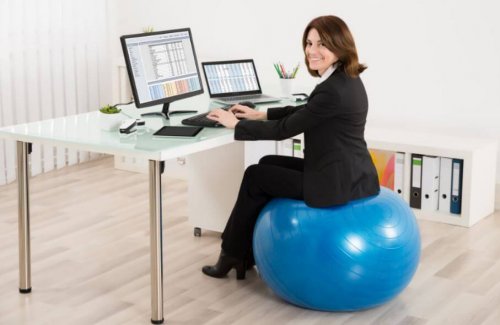Physiotherapy for the Musculoskeletal System

The musculoskeletal system is responsible for the voluntary movements that our body makes. This system includes the skeletal and muscular system, which work with the nervous system to make movements possible and to support and protect the organs in the body.
Physiotherapy for the musculoskeletal system
Physiotherapy is the treatment of injuries through exercises, massages or mechanical and physical means. Moreover, physiotherapy of the musculoskeletal system focuses on treating issues of the skeletal, muscular and nervous system.

The human body has many different organs that are classified in systems. Each system has different purposes and cooperates with others to maintain the standard quality for the functioning of the body. The musculoskeletal system composition is the following:
- Bones.
- Joints.
- Ligaments.
- Muscles.
- Tendons.
- Cartilage.
For all these organs to work properly, they depend on the nervous system, which is in charge of transmitting the motor commands. This way, muscular, skeletal and nervous systems work for the mobility of the body and thus, provide the human body with the freedom to move.
We are movement
Many people think that the most important things needed for a human to stay alive are water and food. This is true, without water or food, the body would collapse. However, from prehistorical times, humans had to search for food and water to survive. In other words, the musculoskeletal system plays a very important role in survival. Without all the organs in this system, the human body wouldn’t be able to do what it must do to meet its basic needs.
Nowadays, work, studies, transport and all the elements that make up our daily life, cause the musculoskeletal system to deteriorate and even makes us overlook its proper functioning. We focus most of our energies into our responsibilities and not on our health. The truth is that we humans are movement. If we’re unable to make movements, we don’t have the necessary tools to survive.
What if you don’t take care of your musculoskeletal system?
Often the body is exposed to situations that may affect its functions. There are moments in which we could severely harm our musculoskeletal system, as well as other times in which we’re already gradually causing harm. Whichever the case, the musculoskeletal system can deteriorate due to bad posture.
Bad posture can cause pain in the joints and muscles, headaches, injuries, and even fractures. Therefore, it’s important to avoid putting the body in harmful positions and to be extremely careful when performing physical activity that the body is not used to (such as certain sports, dance, recreational activities, among others.)
The chair is your enemy
The good news is that physiotherapy of the musculoskeletal system can fix these problems. Of course, it’s better to prevent any injury in the first place and be careful with what you do to your body.
At times though, we can’t avoid being in situations that are not very good for our bodies, and that’s normal. The trick is reducing the impact of those situations.
There are some small changes that you can start making in your daily life:
- Replace your office chair with a Pilates ball: this alternative is for those who work in an office and spend most of the day sitting. Yes, it sounds weird, but having a Pilates ball as a chair is actually a good idea!

The reasoning behind this is that the human body is not designed to sit all day. Sitting for long periods can harm your joints and muscles due to bad posture.
But, a Pilates ball changes that, because you’ll have to make movements every now and then to maintain your balance, which improves circulation, aligns the spine and prevents bad posture.
- Stretch daily: in order to maintain your musculoskeletal system, it’s beneficial to do stretching exercises or yoga, Pilates, etc. Stretching increases blood flow, oxygenates and strengthens the muscles, joints, and ligaments.
- Get enough rest: yes, it’s that simple! If your daily routine is physically demanding, you must get enough rest to prevent muscle pain.
Physiotherapy to the rescue
There are circumstances when you must visit a physiotherapist since there are injuries that need to be treated by a professional. For example, in cases of osteoarthritis, arthritis, and carpal tunnel syndrome, physiotherapy can be very helpful.
It’s also important that you pay attention to what your body tells you. If you have recurrent pain in your muscles or tendons, visit a physiotherapist. Don’t wait until the pain gets worse.
Today’s physiotherapy has developed so many ways to treat different cases successfully.
Take care of your body, especially your musculoskeletal system. If it’s not working properly, you won’t be able to enjoy simple daily activities. Similarly, if something severe happens to your body, don’t hesitate to seek the help and advice of a physiotherapist.
The musculoskeletal system is responsible for the voluntary movements that our body makes. This system includes the skeletal and muscular system, which work with the nervous system to make movements possible and to support and protect the organs in the body.
Physiotherapy for the musculoskeletal system
Physiotherapy is the treatment of injuries through exercises, massages or mechanical and physical means. Moreover, physiotherapy of the musculoskeletal system focuses on treating issues of the skeletal, muscular and nervous system.

The human body has many different organs that are classified in systems. Each system has different purposes and cooperates with others to maintain the standard quality for the functioning of the body. The musculoskeletal system composition is the following:
- Bones.
- Joints.
- Ligaments.
- Muscles.
- Tendons.
- Cartilage.
For all these organs to work properly, they depend on the nervous system, which is in charge of transmitting the motor commands. This way, muscular, skeletal and nervous systems work for the mobility of the body and thus, provide the human body with the freedom to move.
We are movement
Many people think that the most important things needed for a human to stay alive are water and food. This is true, without water or food, the body would collapse. However, from prehistorical times, humans had to search for food and water to survive. In other words, the musculoskeletal system plays a very important role in survival. Without all the organs in this system, the human body wouldn’t be able to do what it must do to meet its basic needs.
Nowadays, work, studies, transport and all the elements that make up our daily life, cause the musculoskeletal system to deteriorate and even makes us overlook its proper functioning. We focus most of our energies into our responsibilities and not on our health. The truth is that we humans are movement. If we’re unable to make movements, we don’t have the necessary tools to survive.
What if you don’t take care of your musculoskeletal system?
Often the body is exposed to situations that may affect its functions. There are moments in which we could severely harm our musculoskeletal system, as well as other times in which we’re already gradually causing harm. Whichever the case, the musculoskeletal system can deteriorate due to bad posture.
Bad posture can cause pain in the joints and muscles, headaches, injuries, and even fractures. Therefore, it’s important to avoid putting the body in harmful positions and to be extremely careful when performing physical activity that the body is not used to (such as certain sports, dance, recreational activities, among others.)
The chair is your enemy
The good news is that physiotherapy of the musculoskeletal system can fix these problems. Of course, it’s better to prevent any injury in the first place and be careful with what you do to your body.
At times though, we can’t avoid being in situations that are not very good for our bodies, and that’s normal. The trick is reducing the impact of those situations.
There are some small changes that you can start making in your daily life:
- Replace your office chair with a Pilates ball: this alternative is for those who work in an office and spend most of the day sitting. Yes, it sounds weird, but having a Pilates ball as a chair is actually a good idea!

The reasoning behind this is that the human body is not designed to sit all day. Sitting for long periods can harm your joints and muscles due to bad posture.
But, a Pilates ball changes that, because you’ll have to make movements every now and then to maintain your balance, which improves circulation, aligns the spine and prevents bad posture.
- Stretch daily: in order to maintain your musculoskeletal system, it’s beneficial to do stretching exercises or yoga, Pilates, etc. Stretching increases blood flow, oxygenates and strengthens the muscles, joints, and ligaments.
- Get enough rest: yes, it’s that simple! If your daily routine is physically demanding, you must get enough rest to prevent muscle pain.
Physiotherapy to the rescue
There are circumstances when you must visit a physiotherapist since there are injuries that need to be treated by a professional. For example, in cases of osteoarthritis, arthritis, and carpal tunnel syndrome, physiotherapy can be very helpful.
It’s also important that you pay attention to what your body tells you. If you have recurrent pain in your muscles or tendons, visit a physiotherapist. Don’t wait until the pain gets worse.
Today’s physiotherapy has developed so many ways to treat different cases successfully.
Take care of your body, especially your musculoskeletal system. If it’s not working properly, you won’t be able to enjoy simple daily activities. Similarly, if something severe happens to your body, don’t hesitate to seek the help and advice of a physiotherapist.
This text is provided for informational purposes only and does not replace consultation with a professional. If in doubt, consult your specialist.








